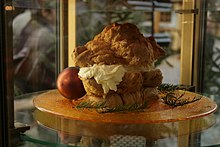Profiterole
A profiterole (French: [pʁɔfitʁɔl]), cream puff (US), or chou à la crème (French: [ʃu a la kʁɛm]) is a filledFrench choux pastry ball with a typically sweet and moist filling of whipped cream, custard, pastry cream, or ice cream. The puffs may be decorated or left plain or garnished with chocolate sauce, caramel, or a dusting of powdered sugar. Savory profiterole are also made, filled with pureed meats, cheese, and so on. These were formerly common garnishes for soups.[1]
The various names may be associated with particular variants of filling or sauce in different places.[2][3][4][5]
Preparation
Choux pastry dough is piped through a pastry bag or dropped with a pair of spoons into small balls and baked to form largely hollow puffs. After cooling, the baked profiteroles are injected with filling using a pastry bag and narrow piping tip, or by slicing off the top, filling them, and reassembling. For sweet profiteroles, additional glazes or decorations may then be added.
Presentation


The most common presentations are pastry cream, whipped cream, or ice cream filling, topped with powdered sugar or chocolate ganache and possibly more whipped cream. They are also served plain, with a crisp caramel glaze, iced, or with fruit.
Filled and glazed with caramel, they are assembled into a type of pièce montée called croquembouches, often served at weddings in France and Italy, during the Christmas holiday in France, and are served during important celebrations in Gibraltar. Profiteroles are also used as the outer wall of St. Honoré Cake.
History
The French word profiterole ‘small profit, gratification’ has been used in cuisine since the 16th century.[6]
In the 17th century, profiteroles were small hollow bread rolls filled with a mixture of sweetbreads, truffles, artichoke bottoms, mushrooms, pieces of partridge, pheasant, or various poultry, accompanied by garnish. They could also be served in a soup.[7][8]
François Massialot in Le Cuisinier royal et bourgeois[9] (1698) gives several recipes for profiterole soup, with fillings of minced ham and poultry on a stew of mushrooms, asparagus, artichoke bottoms, rooster crests, sweetbreads, and truffles. The profiteroles are made of bread dough.
Joseph Menon in his Traité de cuisine[10] (1732) and François Marin in Les Dons de Comus[11] (1750) give other examples of savory recipes while keeping the same principle.
The profiteroles we know today, using choux pastry, were created in the 19th century.
Jules Gouffé in his Livre de cuisine[12] (1870) explains that a profiterole is a small choux pastry. Gustave Garlin in Le Cuisinier moderne[13] (1887) mentions profiteroles filled with cream and glazed with chocolate or coffee, worked to be smooth and shiny.
A widely-repeated legend claims that choux pastry, the key ingredient of profiteroles, was invented by the head chef to the court of Catherine de’ Medici.[14] But this is a 19th-century invention.[15]
The pastry cook’s art of choux pastry began to develop around the 17th century.[14] The patissier Jean Avice[16]developed the pastry further in the middle of the eighteenth century and created choux buns, with the dough becoming known as ‘pâte à choux’, since only choux buns were made from it. In the 19th century, Antoine Carême developed the recipe used today.[17]
United States
Cream puffs have appeared on U.S. restaurant menus since at least 1851.[18]
The Wisconsin State Fair is known for its giant cream puffs.[19][20]
In Hawaii, coco puffs (not to be confused with Cocoa Puffs) made by Liliha Bakery are a popular dessert. They are filled with chocolate creme patissiereand topped with a frosting known as “chantilly” (similar to German chocolate cake sans coconut and nuts).[21]
In popular culture
In the Japanese murder mystery sound novel series Higurashi When They Cry, the character Hanyū enjoys cream puffs, singing in one song that “I love, I love, I really love chou à la crème!”.
In the Japanese manga series Mashle, main character Mash Burnedead has an obsession for cream puffs.
In the 1989 film The Cook, the Thief, His Wife & Her Lover, profiteroles are a favorite treat of the titular wife, Georgina Spica.
Profiteroles are served in the banquet scene in the 2017 film Victoria & Abdul, in which Queen Victoria is seen to be taking great pleasure in devouring her serving of them.[22]



 ID
ID

nice info
🙂
An interesting topic and I’m glad to come across your page where I found some helpful insights. Check out my website FQ6 too, if you need additional resources about Cosmetics.
TONY20251128. 888slot – cái tên top đầu trong lĩnh vực cá cược, đã chọn 888slot GAME làm đại lý chính thức để cung cấp link truy cập an toàn. Đây là đại lý được cấp quyền trực tiếp, chịu trách nhiệm cung cấp đường link 888slot ổn định và bảo mật tại Việt Nam. Để không bỏ lỡ 150.000 VNĐ tiền cược trải nghiệm miễn phí; 100% tiền nạp đầu và vô số ưu đãi độc quyền khác, hãy đăng ký tài khoản tại 888slot GAME với thông tin chính chủ ngay hôm nay.
TONY20251128. 888slot – cái tên top đầu trong lĩnh vực cá cược, đã chọn 888slot GAME làm đại lý chính thức để cung cấp link truy cập an toàn. Đây là đại lý được cấp quyền trực tiếp, chịu trách nhiệm cung cấp đường link 888slot ổn định và bảo mật tại Việt Nam. Để không bỏ lỡ 150.000 VNĐ tiền cược trải nghiệm miễn phí; 100% tiền nạp đầu và vô số ưu đãi độc quyền khác, hãy đăng ký tài khoản tại 888slot GAME với thông tin chính chủ ngay hôm nay.
TONY20251128. 888slot – cái tên top đầu trong lĩnh vực cá cược, đã chọn 888slot GAME làm đại lý chính thức để cung cấp link truy cập an toàn. Đây là đại lý được cấp quyền trực tiếp, chịu trách nhiệm cung cấp đường link 888slot ổn định và bảo mật tại Việt Nam. Để không bỏ lỡ 150.000 VNĐ tiền cược trải nghiệm miễn phí; 100% tiền nạp đầu và vô số ưu đãi độc quyền khác, hãy đăng ký tài khoản tại 888slot GAME với thông tin chính chủ ngay hôm nay.
Đăng ký tài khoản tại 888slot cực kỳ đơn giản, chỉ mất chưa đầy 30 giây là bạn đã có thể bắt đầu hành trình chinh phục giải thưởng. TONY01-08